Essential Precautions You Should Take Before and After Your Dental Filling Treatment
Summary: Dental fillings are a routine dental procedure aimed at restoring decayed teeth. However, to ensure a smooth process and successful recovery, it is crucial to take essential precautions before and after the treatment. This article highlights four key areas to address: understanding the procedure, preparing adequately, following post-treatment care, and maintaining oral hygiene. By adhering to these guidelines, patients can minimize discomfort, speed up healing, and ensure the longevity of their dental fillings. Educing risks through informed decisions leads to a successful dental experience and a healthier smile.
1. Understanding the Dental Filling Procedure

Before undergoing a dental filling treatment, patients must familiarize themselves with what the procedure involves. Understanding the steps taken during the process can significantly alleviate anxiety and help in managing expectations. Typically, your dentist will first administer a local anesthetic to numb the affected area before removing decayed material from the tooth.
After the decay removal, the dentist prepares the cavity for filling. This involves cleaning the area and ensuring a proper fit for the filling material. Being aware of these steps provides a clear picture of the treatment process and prepares patients for what lies ahead.
An additional aspect of understanding the procedure is to discuss potential outcomes and complications with your dentist. Knowledge about what to expect during and after treatment can help you address concerns effectively and prepare mentally for recovery.
2. Preparing for Your Dental Appointment
Preparation is pivotal for a successful dental filling treatment. One significant step is scheduling your appointment appropriately. Consider times when you can relax afterward and avoid any activities that require extensive focus, as some discomfort may arise post-treatment.
Patients should also compile essential health information to share with their dentist. This includes disclosing any medications you are currently taking, allergies, and previous dental treatments. Providing this information enables your dentist to tailor the treatment approach to your specific needs.
Finally, arrange transportation if necessary. After treatment, especially if you have received sedation, you may be advised not to drive. Having a reliable ride home ensures you can focus on recovery without added stress or complications.
3. Post-Treatment Care Instructions
Once the dental filling has been successfully placed, following post-treatment care is crucial. Initially, patients should wait for the anesthesia to wear off before eating or drinking to avoid biting their cheeks or tongue unintentionally. Soft foods are recommended immediately after treatment to prevent putting unnecessary pressure on the filling.
Another important post-care instruction is pain management. Some discomfort may be normal, and over-the-counter pain relief medications can help. However, if the pain persists or worsens, contacting your dentist is essential to rule out complications.
Moreover, patients should avoid hard or sticky foods for the first few days after treatment. Such foods can dislodge the filling or cause discomfort, undermining the healing process. Gradually reintroducing a normal diet can promote a smoother recovery.
4. Maintaining Good Oral Hygiene Habits
After receiving a dental filling, maintaining good oral hygiene becomes more critical than ever. Brushing and flossing regularly help prevent future dental issues and keep the filling intact. It is advisable to use a soft-bristle toothbrush to gently clean the area around the filling.
Additionally, consider rinsing with an antibacterial mouthwash to eliminate harmful bacteria that could lead to decay around the filling. Good oral hygiene practices can extend the life of the filling and promote overall dental health.
Finally, regular dental check-ups are paramount. Schedule follow-up appointments to let your dentist assess the filling and your general oral health. Professional cleanings and check-ups can identify potential issues before they escalate, ensuring your dental fillings remain effective for as long as possible.
Summary:
In summary, ensuring a successful dental filling treatment involves various essential precautions. By understanding the procedure, preparing adequately, adhering to post-treatment care, and maintaining good oral hygiene, patients can enhance their recovery experience and safeguard their dental health. Knowledge and preparation are the cornerstones of achieving optimal dental outcomes.
This article is compiled by Vickong Dental and the content is for reference only.


